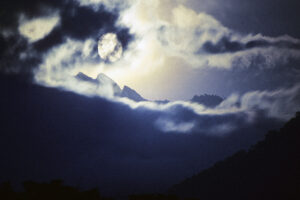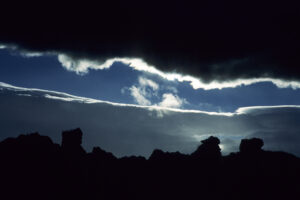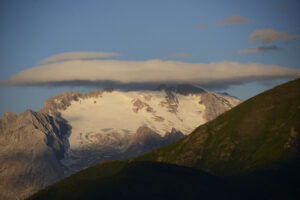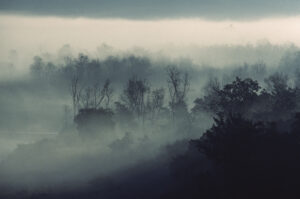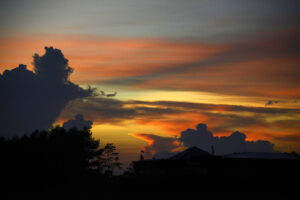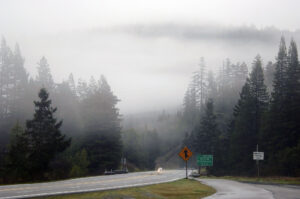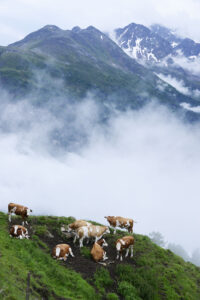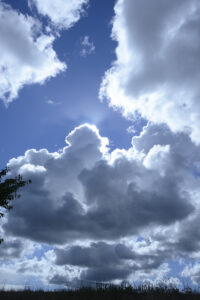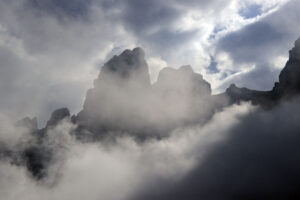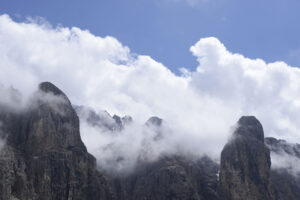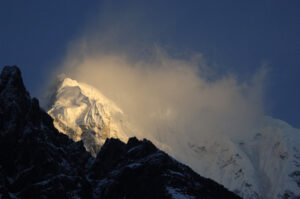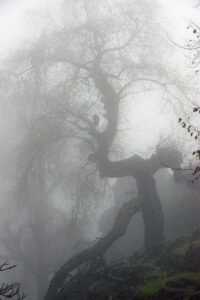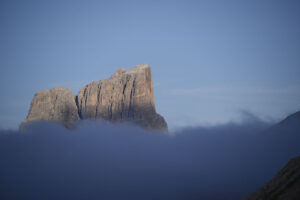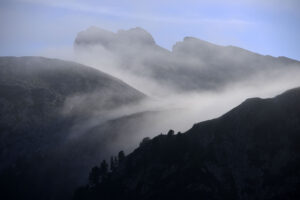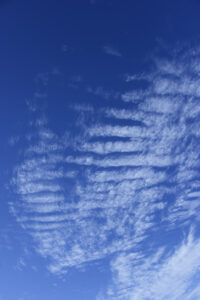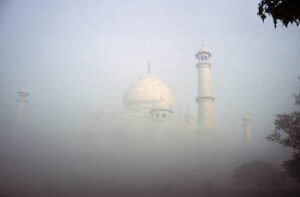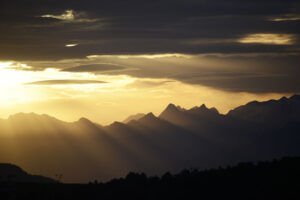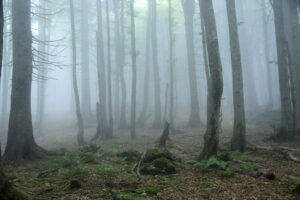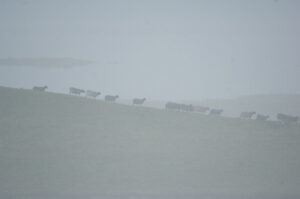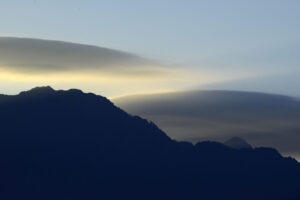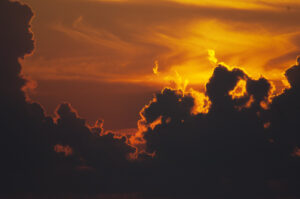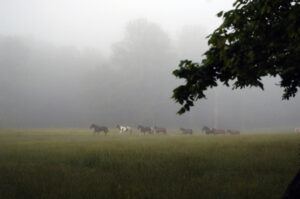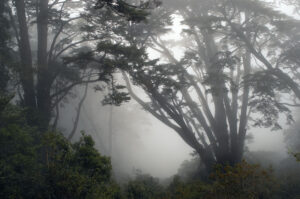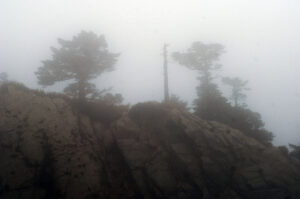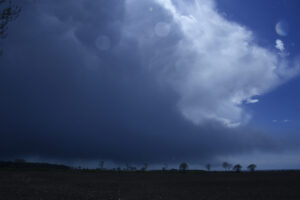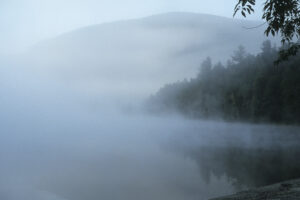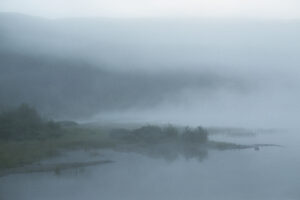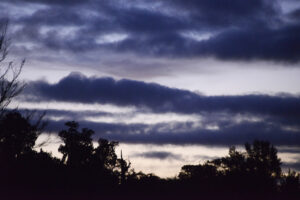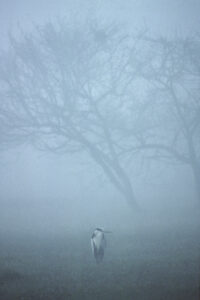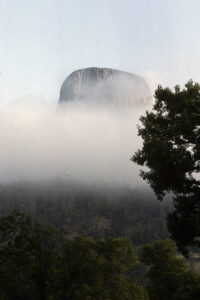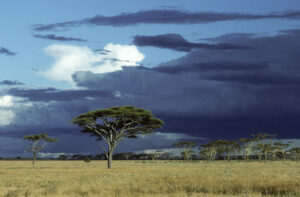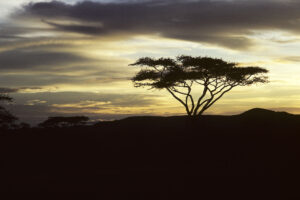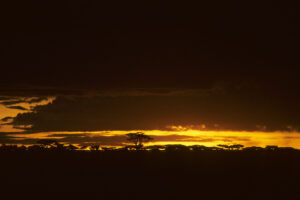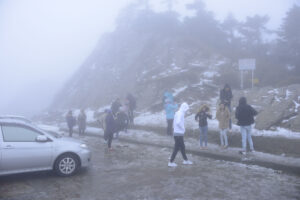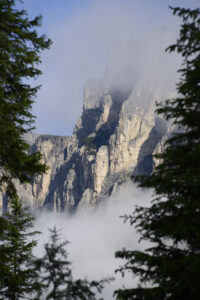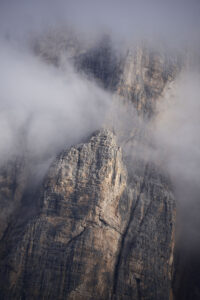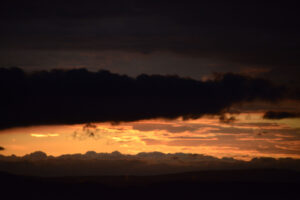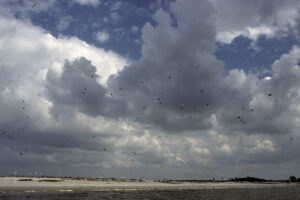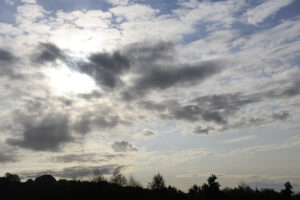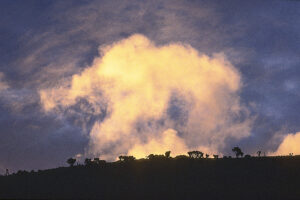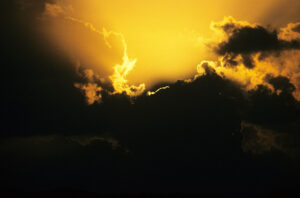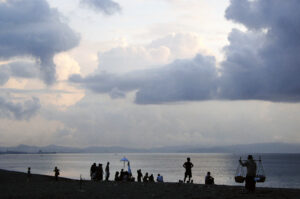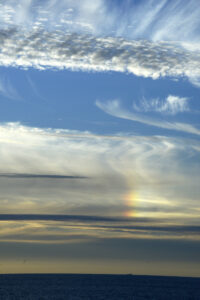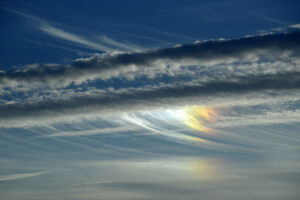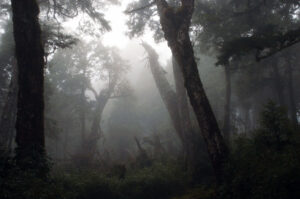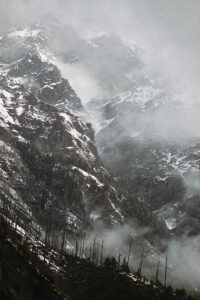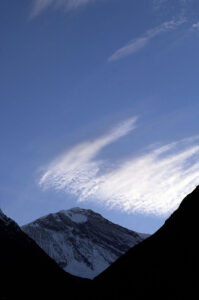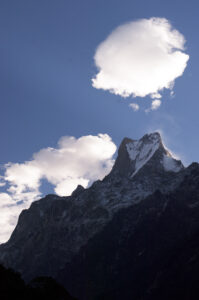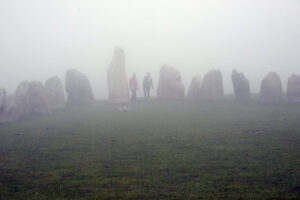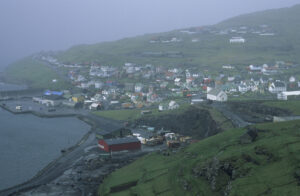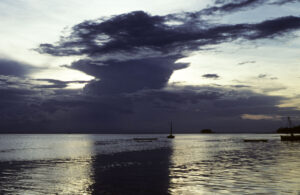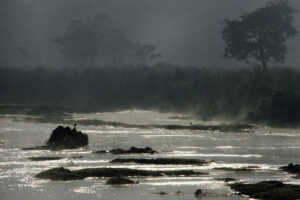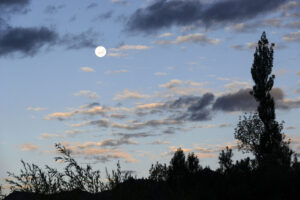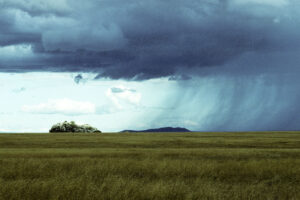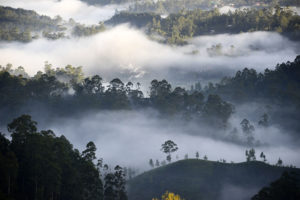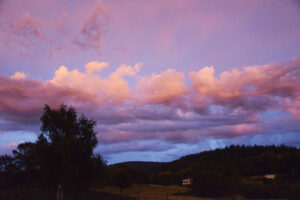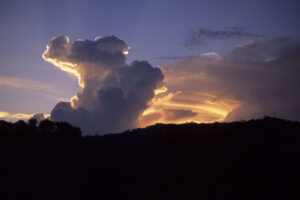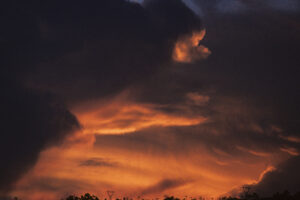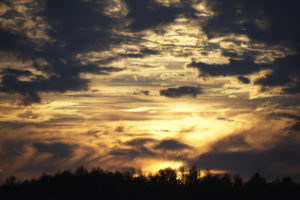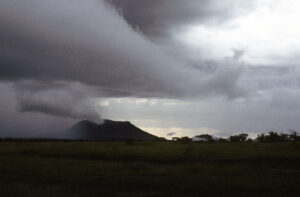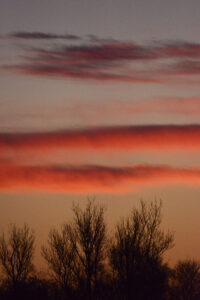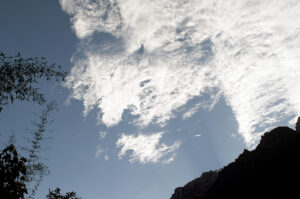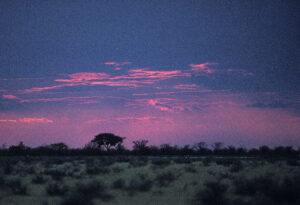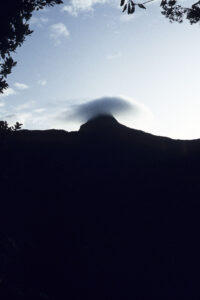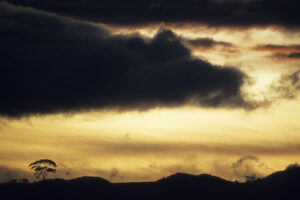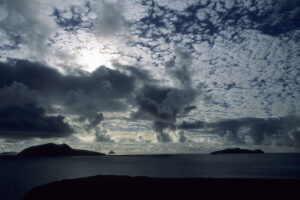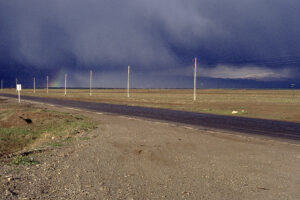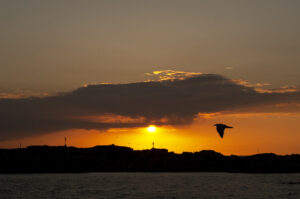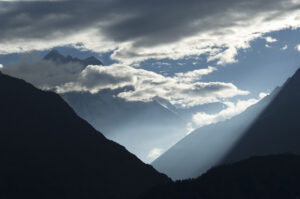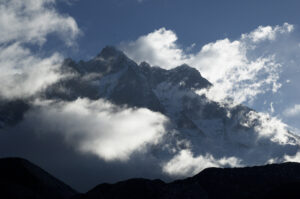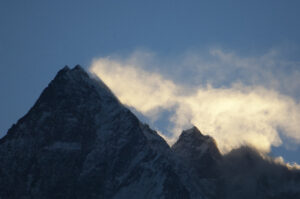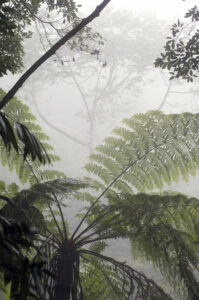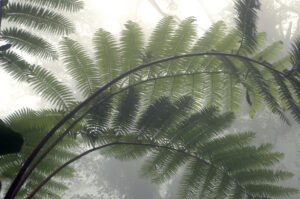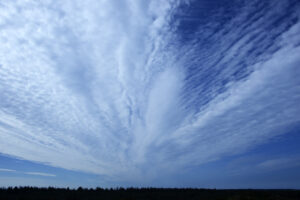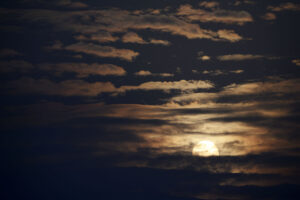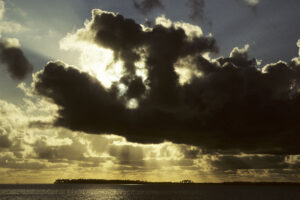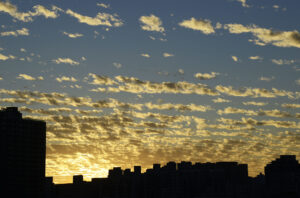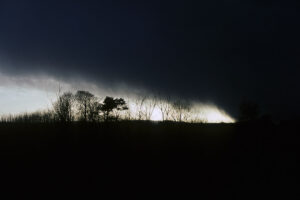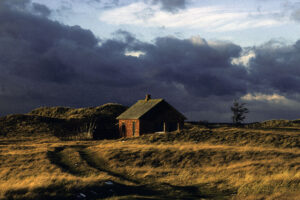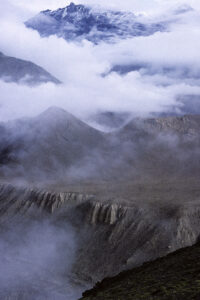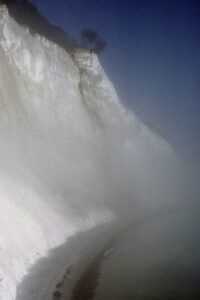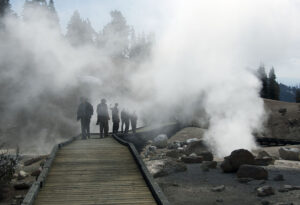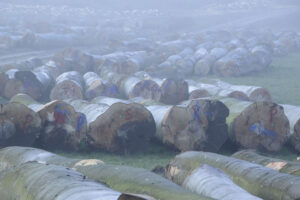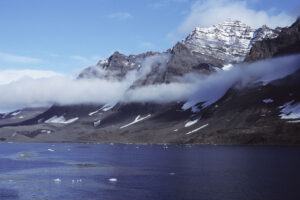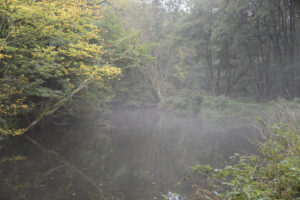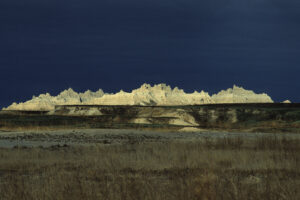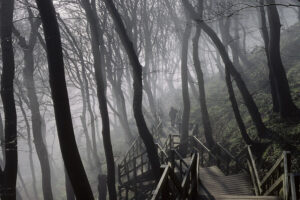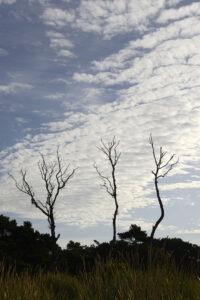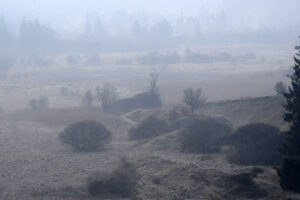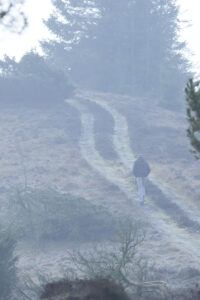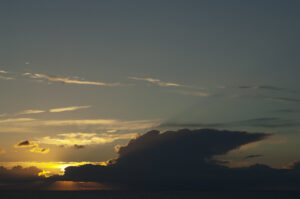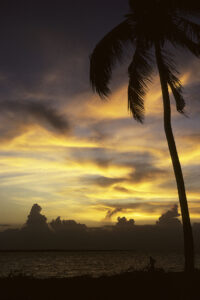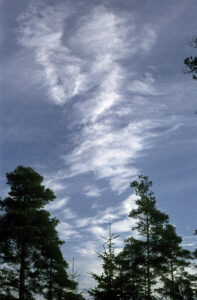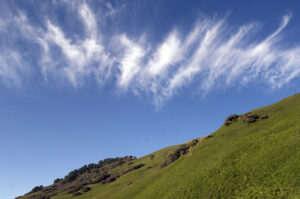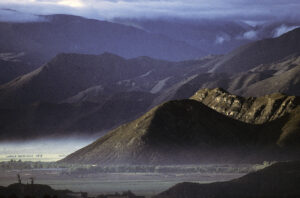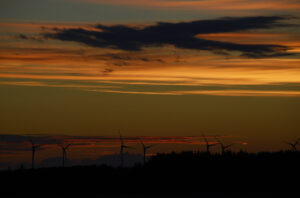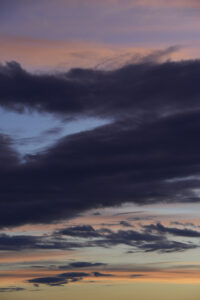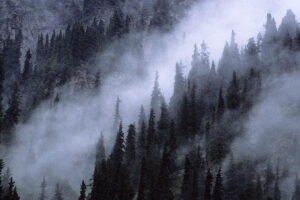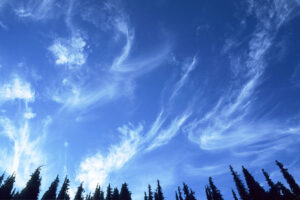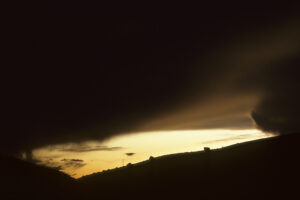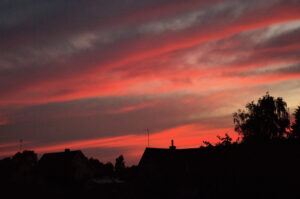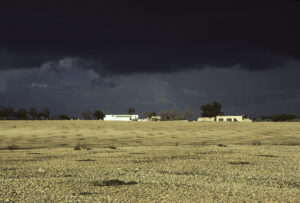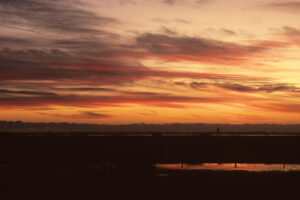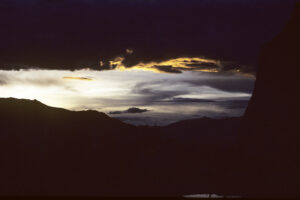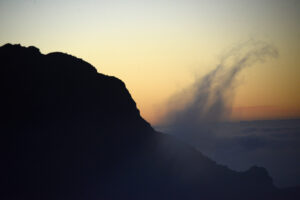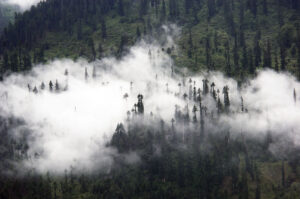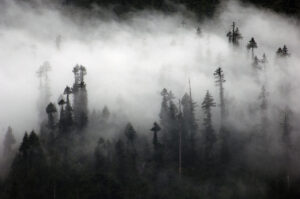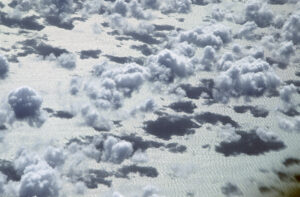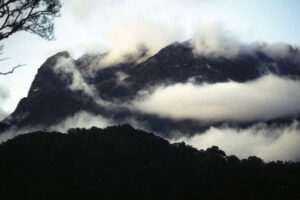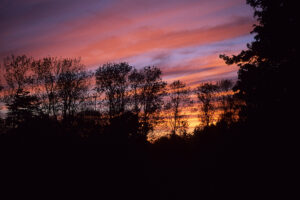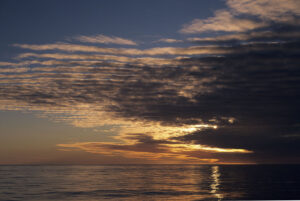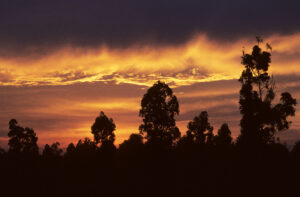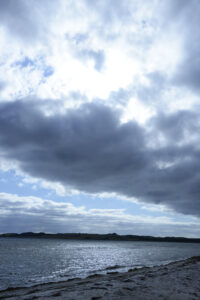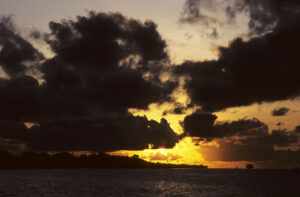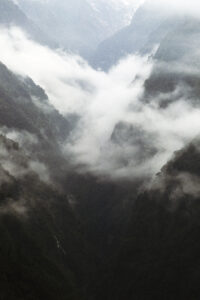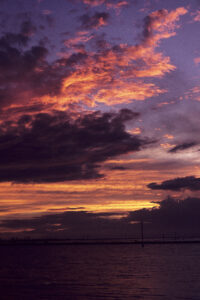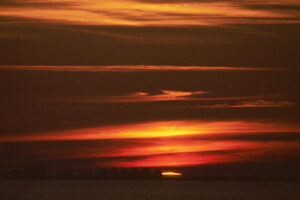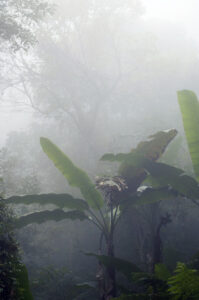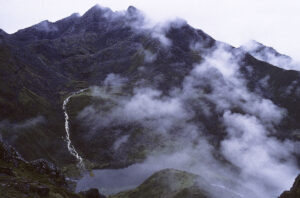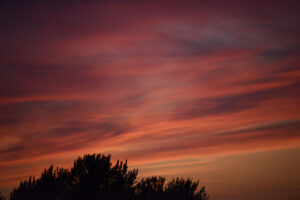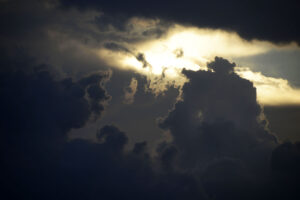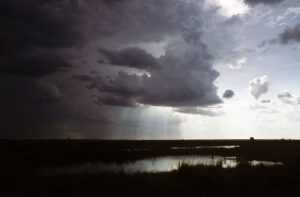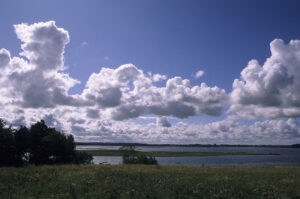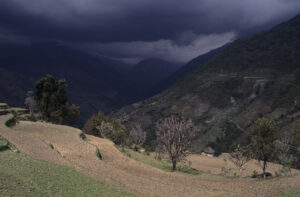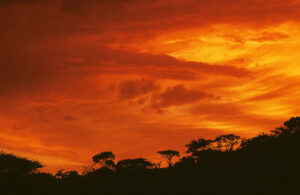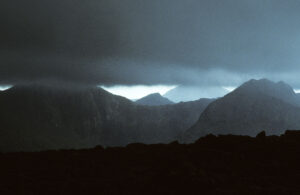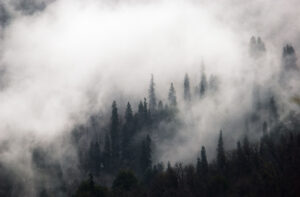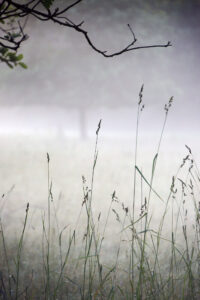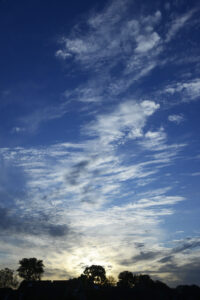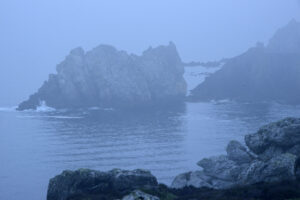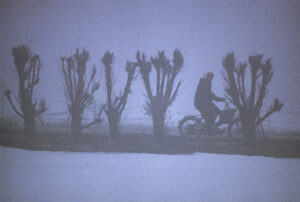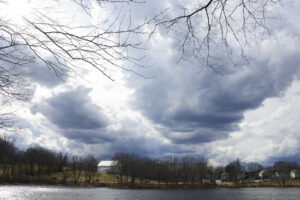Clouds and fog
Full moon above the Ruwenzori Mountains, Virunga National Park, eastern Zaire. Since Ancient Greece, these mountains have been known as ‘Mountains of the Moon’. This area is described in depth on the page Travel episodes – Zaire 1981: The ghost forest. (Photo copyright © by Kaj Halberg)
Evening atmosphere with clouds and lava formations, Aðaldal Valley, northern Iceland. (Photo copyright © by Kaj Halberg)
Flat cloud above Punta Penia (3343 m), Marmolada group, seen from Passo Falzárego, Dolomites, Italy. (Photo copyright © by Kaj Halberg)
Morning fog, Corbett National Park, Uttarakhand, India. (Photo copyright © by Kaj Halberg)
Clouds at dawn, Kintamani, Bali. (Photo copyright © by Kaj Halberg)
Conifers and fog, near Myers Flat, California. (Photo copyright © by Kaj Halberg)
Pied Alp cattle, grazing near Kasereck, Grossglockner, Austria. This breed and many other types of cattle are described on the page Animals: Animals as servants of Man. (Photo copyright © by Kaj Halberg)
Three different lines of condensed exhaust from jetplanes, Mohave National Preserve, California. (Photo copyright © by Kaj Halberg)
Cumulus clouds, eastern Funen, Denmark. (Photo copyright © by Kaj Halberg)
Sella group, seen from Val Gardena (top) and Passo Gardena, Dolomites, Italy. (Photos copyright © by Kaj Halberg)
Mount Taranaki is a dormant volcano on the west coast of the North Island, New Zealand. This striking mountain rises to a height of 2,518 m from the surrounding lowland. It was named Taranaki by the Maori, from the words tara (‘mountain peak’), and, presumably, ngaki (‘shining’), alluding to its snow-covered peak.
Until recently, the official name of this mountain was Egmont, thus named by British explorer and captain James Cook (1728-1779), in honour of John Perceval, 2nd Earl of Egmont (1711-1770), who, as former First Lord of the Admiralty, had supported the search for Terra Australis Incognita.
Fog around a mountain hut, Mt. Taranaki. (Photo copyright © by Kaj Halberg)
Morning light on Langtang Lirung (7245 m), seen from Kyanjin Gompa, Langtang National Park, Nepal. (Photo copyright © by Kaj Halberg)
Dense fog, near Artenara, Gran Canaria. (Photo copyright © by Kaj Halberg)
Clouds around mountains near Passo di Valparola (2192 m), Dolomites, Italy. (Photos copyright © by Kaj Halberg)
Clouds, Ohakune, North Island, New Zealand. (Photo copyright © by Kaj Halberg)
Shah Jahan (1592-1666), 5th emperor of the Muslim Moghul Empire in northern India, is most famous for ordering the construction of Taj Mahal (‘Crown of the Palace’), a mausoleum near the city of Agra, erected in honour of his favourite wife, Arjumand Banu Begum, called Mumtaz Mahal (‘Chosen One of the Palace’). She died in 1630 after giving birth to her fourteenth child. Construction of this mausoleum lasted 22 years, from 1632 to 1654.
Taj Mahal in morning fog. (Photo copyright © by Kaj Halberg)
Morning light on mountains around Mont Blanc, seen from Col de la Madelaine, France. (Photo copyright © by Kaj Halberg)
Fog in a spruce forest, between Prtovč and Ratitovec, Triglavski National Park, Slovenia. (Photo copyright © by Kaj Halberg)
On a foggy day, sheep are running down a slope on an islet in Roskilde Fjord, Zealand, Denmark. The domestic sheep is described on the page Animals: Animals as servants of Man. (Photo copyright © by Kaj Halberg)
Morning sky, Wushe, central Taiwan. (Photo copyright © by Kaj Halberg)
Clouds at sunset, Zonguldak, northern Turkey. (Photo copyright © by Kaj Halberg)
Horses in morning fog, Cades Cove, Great Smoky Mountains National Park, Tennessee, United States. The domestic horse is described on the page Animals: Animals as servants of Man. (Photo copyright © by Kaj Halberg)
The Chinese hemlock (Tsuga chinensis) is distributed from Tibet eastwards to China and Taiwan, and thence southwards to northern Vietnam, growing at altitudes between 1,000 and 3,500 m.
A large tree, to 45 m tall, with scaly, grey or blackish-brown bark, alternating with pale yellowish-brown, corky bark. The linear and flat needles are olive-green, to 2 cm long, arranged spirally, grooved on the upperside, with two white stomatic bands below. Male cones are single or in groups up to 5, purple, to 8 mm long. The small, pendulous female cones are reddish-brown, ovoid, to 2 cm long and 1 cm wide.
Taiwan is home to a variety of Chinese hemlock, formosana, which is quite common in mixed broad-leaved forests in montane areas of the island, at altitudes between 1,700 and 3,500 m. Some authorities question the validity of this variety, claiming that it is identical with the type.
The common name alludes to the similarity in the smell of the crushed foliage to that of the poison hemlock (Conium maculatum). The foliage, however, is not poisonous.
Morning fog in a forest with old Taiwan hemlocks, Hohuan Shan Mountain. (Photo copyright © by Kaj Halberg)
These stunted hemlocks grow on an exposed mountain side atop Hohuan Shan. (Photo copyright © by Kaj Halberg)
Thunder cloud with many plasma ‘balls’, one of which is emitting much light (the small white dot), near Albrunna Lund, Öland, Sweden. These ‘balls’ were invisible to the naked eye. Plasma is discussed on the page Book: Seed of Knowledge, Stone of Plenty, Chapter 6. (Photo copyright © by Kaj Halberg)
Morning fog, Natanis Pond, Maine, United States. (Photos copyright © by Kaj Halberg)
Evening sky, Ohakune, North Island, New Zealand. (Photo copyright © by Kaj Halberg)
Morning fog, Keoladeo National Park, Rajasthan, India. The bird is a grey heron (Ardea cinerea). This species is described on several pages on this website, including Fishing, Animals: Urban animal life, and Animals – Birds: Birds in the Indian Subcontinent. (Photo copyright © by Kaj Halberg)
Devil’s Tower is a rock formation in north-eastern Wyoming – presumably the eroded remnant of a laccolith, a large mass of magma, which is intruded through sedimentary rock. As the magma cooled, 6-sided (sometimes 4-, 5-, and 7-sided) vertical columns formed. This amazing rock rises dramatically above the Belle Fourche River, 265 m high from base to summit.
For hundreds of years, this rock has been sacred to local peoples, such as Lakota, Cheyenne, and Kiowa, and it appears in the mythologies of several other tribes. Today, it is the site of tribal vision quests and other rituals, and in the surrounding grasslands, Sun Dances and other tribal ceremonies are performed.
Vision quests are described in detail on the page Book: Seed of Knowledge, Stone of Plenty, Chapter 3.
Morning fog, enveloping Devil’s Tower. (Photo copyright © by Kaj Halberg)
The umbrella acacia (Vachellia tortilis), previously known as Acacia tortilis, was named due to the shape of the crown, which is often broad and curved like an umbrella. It is a very widespread and common tree, to 20 m tall, distributed in the entire northern Africa, southwards to Senegal and Chad, and in a broad belt from Egypt southwards through eastern Africa to South Africa and southern Namibia. It also occurs in the Middle East, from Syria southwards through the entire Arabian Peninsula.
Previously, it was thought that 4 acacia species occurred in this vast area, but research has shown that they are all subspecies of V. tortilis. (Source: fao.org/3/Q2934E)
Other species of acacia are described on the page In praise of the colour yellow.
The umbrella acacia is very common on the East African savanna. These pictures are from Serengeti National Park, Tanzania (upper 3), and Masai Mara National Park, Kenya. (Photos copyright © by Kaj Halberg)
Tourists, trying to keep warm in fog and snow, Hohuan Shan Mountain, Taiwan. (Photo copyright © by Kaj Halberg)
Morning clouds beneath Passo Falzarego, Dolomites, Italy. (Photos copyright © by Kaj Halberg)
Morning sky, Funen, Denmark. (Photo copyright © by Kaj Halberg)
Cumulus clouds above Tso Kar, a high-altitude saline lake, Ladakh, India. (Photo copyright © by Kaj Halberg)
Evening clouds, Steinwald Nature Park, southern Germany. (Photo copyright © by Kaj Halberg)
Cumulus clouds above the islets Mågeøerne, Funen, Denmark. The birds are great cormorants (Phalacrocorax carbo) and herring gulls (Larus argentatus), which breed on these islands. (Photo copyright © by Kaj Halberg)
Various types of clouds, Jutland, Denmark. (Photo copyright © by Kaj Halberg)
Euphorbia candelabrum is a succulent, tree-like species of spurge, usually growing to about 10 m tall, occasionally to 20 m. It is endemic to eastern Africa around the African Horn and along the Great Rift Valley, growing in dry wooded grasslands and on rocky slopes up to an elevation of about 2,200 m.
The specific name alludes to its shape, which resembles a candelabrum, giving rise to the popular name candelabra tree.
A close-up of this plant is shown on the page Silhouettes.
Euphorbia candelabrum, outlined at sunset, Mount Kenya. (Photo copyright © by Kaj Halberg)
Sunset and rain clouds, Jutland, Denmark. (Photo copyright © by Kaj Halberg)
People on the beach, Senggigi, Lombok, Indonesia. (Photo copyright © by Kaj Halberg)
Clouds with a ‘rainbow’, Hanstholm, Thy, Denmark. (Photos copyright © by Kaj Halberg)
Fog in a montane forest with mixed evergreen and deciduous trees, Taipingshan National Forest, eastern Taiwan. (Photo copyright © by Kaj Halberg)
The Annapurna Range in central Nepal contains a number of striking pekas, including Annapurna I (8091 m), Annapurna II (7939 m), Gangapurna (7454 m), Glacier Dome (7193 m), Annapurna South (7219 m), and Machhapuchhare (6993 m).
The latter peak is sacred to Hindus and may not be scaled. In Nepali, Machhapuchhare means ‘fishtail’ – a name given to this mountain in allusion to its twin peaks, which are combined by a curved ridge.
Clouds on the rockface of Annapurna II, seen from the upper Marsyangdi Valley. The conifers in front of the mountain died in a forest fire. (Photo copyright © by Kaj Halberg)
Clouds above Gangapurna, seen from Machhapuchhare Base Camp. (Photo copyright © by Kaj Halberg)
Clouds above Machhapuchhare, seen from Doban. (Photo copyright © by Kaj Halberg)
Strange cloud formation around the peak of Machhapuchhare. The tree is a Nepalese alder (Alnus nepalensis). (Photo copyright © by Kaj Halberg)
Morning fog around Ales Stenar, near the village of Kåseberga, Skåne, Sweden, a megalithic structure from the Bronze Age, consisting of c. 60 stones, erected to form the outline of a ship, c. 80 m long and 20 m wide. (Photo copyright © by Kaj Halberg)
Feather clouds, Jutland, Denmark. (Photo copyright © by Kaj Halberg)
Fog around the town of Eiði, Eysturoy, Faroe Islands. (Photo copyright © by Kaj Halberg)
Anvil cloud over the Indian Ocean, seen from Boydu, Tanzania. (Photo copyright © by Kaj Halberg)
Clouds around Schwarzmönch (2649 m), standing out in front of Jungfrau (4158 m), Lauterbrunnen Valley, Berner Oberland, Switzerland. (Photo copyright © by Kaj Halberg)
Morning clouds over the city of Esbjerg, Jutland, Denmark. (Photo copyright © by Kaj Halberg)
Fog evaporates over the Rapti River, southern Nepal. The birds are little egrets (Egretta garzetta). (Photo copyright © by Kaj Halberg)
Full Moon and clouds at dawn, Leh, Ladakh, India. (Photo copyright © by Kaj Halberg)
Kopjes are isolated rocky outcrops, which, somewhat wantonly, pierce the African savanna here and there. Incidentally, they are the remains of ancient, eroded mountains. To the Boer, when they migrated to southern Africa in the 1700s, these outcrops resembled bald heads, so they named them kopjes (‘heads’ in Dutch).
Rain shower at Simba Kopjes (‘Lion Heads’), Serengeti National Park, Tanzania. (Photo copyright © by Kaj Halberg)
Fog blurs the Xiluo Bridge, 1,939 m long, spanning the Jhuoshuei River, western Taiwan. This bridge was completed in 1952. (Photos copyright © by Kaj Halberg)
Clouds, Jutland, Denmark. (Photo copyright © by Kaj Halberg)
A snow-white stupa is dimmed by evaporating morning clouds, near Haputale, Sri Lanka. Stupas and other aspects of Buddhism are described in depth on the page Religion: Buddhism. (Photo copyright © by Kaj Halberg)
Evening clouds, Bühlertal, Black Mountains, southern Germany. (Photo copyright © by Kaj Halberg)
Cumulus clouds at sunset, Periyar National Park, Kerala, South India. (Photos copyright © by Kaj Halberg)
Evening sky, Aaker Plantation, Bornholm, Denmark. (Photo copyright © by Kaj Halberg)
Heavy rain clouds, Serengeti National Park, Tanzania. (Photo copyright © by Kaj Halberg)
Evening sky, eastern Jutland, Denmark. (Photo copyright © by Kaj Halberg)
Morning clouds above the Modi Khola Valley, Annapurna, Nepal. To the left dwarf bamboo. (Photo copyright © by Kaj Halberg)
Evening sky, Etosha National Park, Namibia. (Photo copyright © by Kaj Halberg)
Adam’s Peak (2243 m) is a mountain in south-western Sri Lanka, sacred to followers of three religions. In a rock on the summit is a depression, shaped like a footprint. Christians and Muslims alike maintain that Adam made this footprint, when he and Eve were expelled from the Garden of Eden after The Fall. Buddhists claim that the Buddha made the footprint when he, according to legend, visited Sri Lanka.
Cloud around the pointed summit of Adam’s Peak at dawn. (Photo copyright © by Kaj Halberg)
Morning sky, Adam’s Peak. (Photo copyright © by Kaj Halberg)
Clouds above Blasket Islands, south-western Ireland. (Photo copyright © by Kaj Halberg)
Rain clouds and rainbow, near Qazvin, north-western Iran. (Photo copyright © by Kaj Halberg)
Sunset behind the bird sanctuary Græsholmen, seen from Frederiksø, Bornholm, Denmark. (Photo copyright © by Kaj Halberg)
Clouds around Lhotse, Khumbu, eastern Nepal, at 8516 m the fourth highest mountain in the world. (Photo copyright © by Kaj Halberg)
Sphaeropteris lepifera is a species of tree fern with a trunk to 6 m tall or more, about 15 cm in diameter. The leaves are very large, to 2 m long, thrice pinnately divided, primary pinnae up to 80 cm long, secondary pinnae usually to 14 cm long. It is found in south-eastern China, Taiwan, the Philippines, and New Guinea, and on the southernmost islands in Japan.
Foggy mountain forest with Sphaeropteris lepifera, Malabang National Forest, near Hsinshu, northern Taiwan. (Photos copyright © by Kaj Halberg)
Clouds, Thy, Denmark. (Photo copyright © by Kaj Halberg)
The sun is penetrating mist and clouds, Taichung, Taiwan. (Photo copyright © by Kaj Halberg)
Sun behind cumulus clouds, Jibondo Island, Tanzania. (Photo copyright © by Kaj Halberg)
Evening clouds, Taichung, Taiwan. The upper picture also shows condensed exhaust from jet planes. (Photos copyright © by Kaj Halberg)
Morning fog, Camaret-sur-Mer, Brittany. (Photo copyright © by Kaj Halberg)
Black rain cloud, passing over the island of Vorsø, Horsens Fjord, Denmark. (Photo copyright © by Kaj Halberg)
Aerial photo south of the Philippines, depicting various types of clouds. (Photo copyright © by Kaj Halberg)
The commonest African fruit bat is the straw-coloured fruit bat (Eidolon helvum), which lives in sub-Saharan savannas and forest, southwards to South Africa, and also in the south-western part of the Arabian Peninsula.
At dusk, thousands of straw-coloured fruit bats leave their day roost to feed in the surrounding area, Kasanka National Park, Zambia. (Photo copyright © by Kaj Halberg)
Clouds and grass-clad dunes in evening light, Ho Bugt, Jutland, Denmark. (Photo copyright © by Kaj Halberg)
Colourful halo around a cloud, Periyar National Park, Kerala, South India. (Photo copyright © by Kaj Halberg)
The barren landscape around the Jhong River Valley, Mustang, Nepal, receives some summer rain. (Photo copyright © by Kaj Halberg)
Morning fog envelops a chalk cliff, named Dronningestolen (‘Queen’s Chair’, 128 m), Møns Klint, Denmark. (Photo copyright © by Kaj Halberg)
Lassen Volcanic National Park, north-eastern California, has several geothermal areas with hot springs and fumaroles (cracks through which sulphurous gases emerge). Bumpass Hell is the most spectacular of these areas. The temperature of the water in this spring has been recorded as being up to 92°C, but temperatures as high as 110°C have been measured in the park.
Bumpass Hell was named after an early settler named Kendall VanHook Bumpass (1809-1885). In 1865, the editor af the newspaper Red Bluff Independent wrote the following:
“Our guide, [Mr. K.V. Bumpass] after cautioning us to be careful where we stepped, that the surface was treacherous, suddenly concluded with Virgil that the “descent to hell was easy”, for stepping upon a slight inequality in the ground he broke through the crust and plunged his leg into the boiling mud beneath, which, clinging to his limb, burned him severely. If our guide had been a profane man I think he would have cursed a little; as it was, I think his silence was owing to his inability to do the subject justice…”
Bumpass later lost his leg by amputation.
Steam from hot springs, Bumpass Hell. (Photo copyright © by Kaj Halberg)
Fog blurs the outline of felled beeches (Fagus sylvatica), eastern Funen, Denmark. (Photo copyright © by Kaj Halberg)
Mountains and clouds, Blosseville Coast, eastern Greenland. (Photo copyright © by Kaj Halberg)
Misty day at River Gudenå, Jutland, Denmark. (Photo copyright © by Kaj Halberg)
Steam from hot springs, Námaskarð, near Myvatn, Iceland. (Photo copyright © by Kaj Halberg)
Fog below the tower on Himmelbjerget (‘Sky Mountain’), central Jutland, Denmark. (Photo copyright © by Kaj Halberg)
Rain clouds and eroded sedimentary rocks, Badlands National Park, South Dakota, USA. (Photo copyright © by Kaj Halberg)
Morning fog in a beech forest (Fagus sylvatica), Møns Klint, Denmark. (Photo copyright © by Kaj Halberg)
Dead trees and clouds, Hagestad Nature Reserve, Skåne, Sweden. (Photo copyright © by Kaj Halberg)
Fog around Ansø Enge and Blæsebjerg (71 m), central Jutland, Denmark. (Photos copyright © by Kaj Halberg)
Evening clouds, Jons Kapel, Bornholm, Denmark. (Photo copyright © by Kaj Halberg)
Fog in a forest near Sanyi, Taiwan. (Photo copyright © by Kaj Halberg)
The place of origin of the coconut palm (Cocos nucifera) is unknown, and today it is found everywhere along tropical coasts, in some areas also inland. This species is utilized for countless purposes. Oil from the nuts, and also dried copra, is used in cooking and in lamps. Mats, weaved from the leaves, are used as walls and roofs in houses, and mats and rope are produced from the fibres in the husk. Charcoal is made from the shells, and the trunk is utilized as timber and firewood.
Coconut palm at sunset, Jangwani Beach, Tanzania. (Photo copyright © by Kaj Halberg)
Clouds above a plantation near Viborg, Jutland, Denmark. (Photo copyright © by Kaj Halberg)
Clouds above a mountain ridge, Ghumtarao, Great Himalayan National Park, Himachal Pradesh, India. (Photo copyright © by Kaj Halberg)
Morning fog, lifting in the valley around Shigatse, Tibet. (Photo copyright © by Kaj Halberg)
Clouds at dawn, Thy, Denmark. (Photos copyright © by Kaj Halberg)
Schrenk’s spruce (Picea schrenkiana) can grow to a large tree, to 50 m tall and with a trunk diameter up to 2 m. It is restricted to the Tien Shan Mountains in Xinjiang, Kazakhstan, and Kyrgyzstan, usually forming pure forests at altitudes between 1,200 and 3,500 m. Two subspecies are found, schrenkiana in Kazakhstan and Xinjiang, and tianshanica in Kyrgyzstan.
It was named in honour of Baltic-German naturalist Alexander von Schrenk (1816-1876), known for his expeditions to Central Asia and northern Russia, and author of Reise nach dem Nordosten des europäischen Rußlands, durch die Tundren der Samojeden, zum arktischen Uralgebirge (1848).
Clouds and Schrenk’s spruces, subspecies tianshanica, Arashan Valley, Kyrgyzstan. (Photos copyright © by Kaj Halberg)
Evening sky, Bighorn Mountains, Wyoming, USA. (Photo copyright © by Kaj Halberg)
Red evening clouds, Funen, Denmark. (Photo copyright © by Kaj Halberg)
Fallow fields, village, and dark rain clouds, near Kairouan, Tunisia. (Photo copyright © by Kaj Halberg)
At dusk, flocks of gulls fly to their night roost, Nature Reserve Tipperne, Ringkøbing Fjord, Denmark. (Photo copyright © by Kaj Halberg)
Evening sky, Gyantse, Tibet. (Photo copyright © by Kaj Halberg)
Evening atmosphere around Roque Bentayga, Gran Canaria. (Photo copyright © by Kaj Halberg)
Monsoon clouds in a coniferous forest of blue pine (Pinus wallichiana), Himalayan cedar (Cedrus deodara), and West Himalayan fir (Abies pindrow), Manali, Himachal Pradesh, India. (Photos copyright © by Kaj Halberg)
Aerial photo of clouds over a sunlit North Sea. (Photo copyright © by Kaj Halberg)
Evening clouds around Mount Kinabalu (4095 m), Sabah, Borneo, the tallest mountain in Malaysia. It is described in depth on the page Travel episodes – Borneo 1985: A hike up Gunung Kinabalu. (Photo copyright © by Kaj Halberg)
Evening sky, Elling Skov, eastern Jutland, Denmark. (Photo copyright © by Kaj Halberg)
The sun is penetrating morning fog over the sea north of Taiwan, with a blurred Zhitou Island. (Photo copyright © by Kaj Halberg)
Evening clouds off the west coast of Greenland. (Photo copyright © by Kaj Halberg)
Sunrise and clouds behind eucalyptus trees, Bwalya Mponda, Ncheta Island, Bangweulu Swamps, Zambia. (Photo copyright © by Kaj Halberg)
Clouds above the Rodopos Peninsula, Crete. (Photo copyright © by Kaj Halberg)
Clouds, Djursland, Denmark. (Photo copyright © by Kaj Halberg)
Sunrise behind clouds, Kwale Island, Tanzania. (Photo copyright © by Kaj Halberg)
Clouds and rainbow above Eskilsø, an island in Roskilde Fjord, Zealand, Denmark. (Photo copyright © by Kaj Halberg)
Evening clouds behind a ruined fort, Markha Valley, Ladakh, India. (Photo copyright © by Kaj Halberg)
Sunrise behind dark clouds, Horsens Fjord, Denmark. (Photo copyright © by Kaj Halberg)
Clouds partly cover the mountain slopes along the Chomro Khola, a tributary to the Modi Khola River, Annapurna, Nepal. (Photo copyright © by Kaj Halberg)
Golden clouds at sunset, Elephant Pass, Sri Lanka. (Photo copyright © by Kaj Halberg)
The sun sets over the Baltic Sea behind fishing huts, Vivesholm, Gotland, Sweden. (Photo copyright © by Kaj Halberg)
The tall and sturdy banana plants are often called banana trees or banana palms, but both these terms are erroneous, as the plant is actually a huge herb, whose ‘trunk’ consists of thick layers of modified, closely packed leaf-stalks, forming a so-called pseudostem (false stem), also called a corm.
These plants, comprising about 85 species of the genus Musa, are native to subtropical and tropical areas, from India eastwards to Taiwan, and thence southwards through Southeast Asia, Indonesia, and New Guinea to northern Australia.
The Taiwan banana (Musa formosana), which may grow to 6 m tall, is endemic to Taiwan, growing on forested slopes, from near sea level to an altitude of about 1,000 m.
Foggy montane forest with Taiwan banana, Malabang National Forest, near Hsinchu, northern Taiwan. (Photo copyright © by Kaj Halberg)
Clouds above the sacred lake Saraswati Kund, Langtang National Park, Nepal. This area is described on the page Countries and places: Sacred lakes of Shiva. (Photo copyright © by Kaj Halberg)
Evening atmosphere, Roskilde Fjord, Zealand, Denmark. (Photo copyright © by Kaj Halberg)
Sun behind clouds, Sri Lanka. (Photo copyright © by Kaj Halberg)
Rain clouds, looming above Ncheta Island, Bangweulu Swamps, Zambia. (Photo copyright © by Kaj Halberg)
Cumulus clouds, Roskilde Fjord, Zealand, Denmark. (Photo copyright © by Kaj Halberg)
While rain clouds are building up over the mountains, the terraced fields in the foreground are still sunlit, Modi Khola Valley, Annapurna, Nepal. (Photo copyright © by Kaj Halberg)
Evening sky, Serengeti National Park, Tanzania. (Photo copyright © by Kaj Halberg)
At dusk, sunlight is reflected on clouds, Gyantse, Tibet. (Photo copyright © by Kaj Halberg)
Rain clouds above Glyder Fawr (999 m), Snowdon National Park, Gwynedd, Wales. (Photo copyright © by Kaj Halberg)
Coniferous forest, partly hidden in clouds, Asi Ganga Valley, Uttarakhand, India. (Photo copyright © by Kaj Halberg)
Feather clouds, eastern Jutland, Denmark. (Photo copyright © by Kaj Halberg)
Common cock’s-foot (Dactylis glomerata) in morning fog, Store Hjøllund Plantation, Jutland, Denmark. This species is described on the page Plants: Grasses. (Photo copyright © by Kaj Halberg)
Clouds at dawn, Avenhorn, near Enkhuizen, Holland. (Photo copyright © by Kaj Halberg)
Fog blurs coastal rocks, Pointe du Toulinguet, Brittany. (Photo copyright © by Kaj Halberg)
Moped, passing by pruned poplars (Populus) in winter fog, Jutland, Denmark. (Photo copyright © by Kaj Halberg)
Wandering cumulus clouds above Kenoza Lake, Winnikenni Park, Haverhill, Massachusetts, United States. (Photo copyright © by Kaj Halberg)
Other pictures, depicting clouds, are shown on the pages Dawn, Evening, and Nature: Rain and dew.
(Uploaded October 2022)
(Latest update March 2025)
